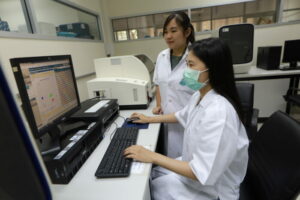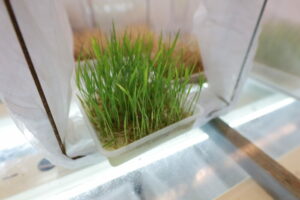Innovative Plant Biotechnology and
Precision Agriculture Research Team
- About
- Services
- Highlights
- Research Personnel
- Contact
Innovative Plant Biotechnology and Precision Agriculture Research Team


Services provided
1. Identification of genes in Thailand’s economic crop plants such as rice maize tomato etc. The genes of interest including rice grain quality, resistance to diseases and insect pests, tolerance to abiotic stresses such as flooding, salinity, heat, drought, and cold.
2. Development of high throughput DNA marker system such as functional SNP markers for important traits.
3. Plant breeding, especially in rice crops, by using the Marker-Assisted Selection (MAS) strategy. The target rice varieties, including the rice varieties for the rain-fed area, the irrigated area, and the rice varieties with high nutrition.
1. Identification of spontaneous mutation for broad-spectrum brown planthopper resistance in a large, long-term fast neutron mutagenized rice population
The development of rice varieties with broad-spectrum resistance to insect pests is the most promising approach for controlling a fast evolving insect pest such as the brown planthopper (BPH). To cope with rapid evolution, discovering new sources of broad-spectrum resistance genes is the ultimate goal. We used a forward genetics approach to identify BPH resistance genes in rice (Oryza sativa L.) using double digest restriction site-associated DNA sequencing (ddRADseq) for quantitative trait loci (QTL)-seq of the backcross inbred lines (BILs) derived from a cross between the BPH-susceptible cultivar KDML105 and BPH-resistant cultivar Rathu Heenati (RH). Two major genomic regions, located between 5.78–7.78 Mb (QBPH4.1) and 15.22–17.22 Mb (QBPH4.2) on rice chromosome 4, showed association with BPH resistance in both pooled BILs and individual highly resistant and susceptible BILs. The two most significant candidate resistance genes located within the QBPH4.1 and QBPH4.2 windows were lectin receptor kinase 3 (OsLecRK3) and sesquiterpene synthase 2 (OsSTPS2), respectively. Functional markers identified in these two genes were used for reverse screening 9323 lines of the fast neutron (FN)-mutagenized population developed from the BPH-susceptible, purple-pigmented, indica cultivar Jao Hom Nin (JHN). Nineteen FN-mutagenized lines (0.24%) carried mutations in the OsLecRK3 and/or OsSTPS2 gene. Among these mutant lines, only one highly resistant line (JHN4) and three moderately resistant lines (JHN09962, JHN12005, and JHN19525) were identified using three active, local BPH populations. The 19 mutant lines together with three randomly selected mutant lines, which did not harbor mutations in the two target genes, were screened further for mutations in six known BPH resistance genes including BPH9, BPH14, BPH18, BPH26, BPH29, and BPH32. Multiple single nucleotide polymorphisms (SNPs) and insertion-deletion (Indel) mutations were identified, which formed gene-specific haplotype patterns (HPs) essential for broad-spectrum resistance to BPH in both BILs and JHN mutant populations. On the one hand, HPs of OsLekRK2–3, OsSTPS2, and BPH32 determined broad-spectrum resistance to BPH among RH-derived BILs. On the other hand, in the JHN mutant population, BPH9 together with seven significant genes on chromosome 4 played a crucial role in BPH resistance. [Rice (2019) 12(16): 1-26, IF 2017 = 3.039]
2. QTL-seq identifies cooked grain elongation QTLs near soluble starch synthase and starch branching enzymes in rice (Oryza sativa L.)
Grain quality is one of the main targets that rice breeders focus on to improve elite rice varieties. Several characteristics are considered when determine rice grain quality, such as aroma, amylose content (AC), gelatinization temperature (GT) and, especially, lengthwise grain elongation (GE). GE is a desirable feature in premium rice of high quality, such as India and Pakistan’ Basmati. Inheritance of GE in rice has not been clearly elucidated due to its complex and inconsistent pattern. In this study, we identified QTLs for GE in rice using bulk-segregant analysis (BSA) and whole-genome sequencing based on an F2 population segregated for GE as well as AC and GT. We identified two QTLs on chromosome 6, qGE6.1 and qGE6.2, and another QTL on chromosome 4, qGE4.1. qGE6.1 and qGE6.2 were located near starch synthase IIa (SSIIa) and starch branching enzyme III (SBEIII), respectively, and qGE4.1 was located near starch branching enzyme IIa (SBEIIa). qGE6.1 was considered to be the major QTL for GE based on this population, and SSIIa was suggested to be the best candidate gene associated with the GE trait. The results of this study may be useful for breeding rice with increased grain elongation and different starch properties. [Scientific Report, 2019, 9:8328, 1-10 (IF 2018 = 4.011)]
3. Genome-wide Association Mapping of Virulence Gene in Rice Blast Fungus Magnaporthe Oryzae Using a Genotyping by Sequencing Approach
Magnaporthe oryzae is a fungal pathogen causing blast disease in many plant species. In this study, seventy three isolates of M. oryzae collected from rice (Oryza sativa) in 1996-2014 were genotyped using a genotyping-by-sequencing approach to detect genetic variation. An association study was performed to identify single nucleotide polymorphisms (SNPs) associated with virulence genes using 831 selected SNP and infection phenotypes on local and improved rice varieties. Population structure analysis revealed eight subpopulations. The division into eight groups was not related to the degree of virulence. Association mapping showed five SNPs associated with fungal virulence on chromosome 1, 2, 3, 4 and 7. The SNP on chromosome 1 was associated with virulence against RD6-Pi7 and IRBL7-M which might be linked to the previously reported AvrPi7. [Genomics, 2019, 111(4): 661-668]
4. Candidate genes and molecular markers associated with brown planthopper (Nilaparvata lugens Stål) resistance in rice cultivar Rathu Heenati.
Brown planthopper (BPH) is a destructive insect pest of rice and causes severe yield loss. In attempts to develop a BPH-resistant rice variety, Rathu Heenati (RH), a rice cultivar with a strong BPH resistance, has been used as the donor in breeding programs. Quantitative trait loci analysis was conducted for the area under the curve of BPH damage scores of a backcross (BC3F5) population infested by six different BPH populations. Single nucleotide polymorphism (SNP) markers on chromosome 4, i.e., LecRK2-SNP and LecRK3-SNP, and markers on chromosome 6, i.e., Bph32-SNP and SSR23, were identified to be associated with resistance against five BPH populations. To identify genes on chromosome 6 that are involved in BPH resistance, expression analysis was conducted for genes located in the genomic region of Bph32-SNP and SSR23. Genes that showed differential expression ofRH at 24 h after BPH infestation, when compared to an RH control, were identified. Those that encode proteins putatively involved in the BPH resistance mechanism are LOC_Os06g03240, LOC_Os06g03380, LOC_Os06g03486, LOC_Os06g03514, LOC_Os06g03520, LOC_Os06g03610, LOC_Os06g03676, and LOC_Os06g03890. SNP markers were developed from several differentially expressed genes and were validated by genotyping in the backcross population. The SNP marker developed from LOC_Os06g03514 showed the highest association with BPH resistance and the gene may be involved in the BPH resistance mechanism. This SNP marker will be useful in breeding programs for BPH resistance. [Molecular Breeding, 2018, 38(88), 1-16]
5. Global Metabolite Profiles of Rice Brown Planthopper-Resistant Traits Reveal Potential Secondary Metabolites for Both Constitutive and Inducible Defenses
Introduction: Brown planthopper (BPH) is a phloem feeding insect that causes annual disease outbreaks, called hopper burn in many countries throughout Asia, resulting in severe damage to rice production. Currently, mechanistic understanding of BPH resistance in rice plant is limited, which has caused slow progression on developing effective rice varieties as well as effective farming practices against BPH infestation. Objective: To reveal rice metabolic responses during 8 days of BPH attack, this study examined polar metabolome extracts of BPH-susceptible (KD) and its BPH-resistant isogenic line (IL308) rice leaves. Methods: Ultra high performance liquid chromatography-quadrupole time-of-flight mass spectrometry (UPLC-QToF-MS) was combined with multi-block PCA to analyze potential metabolites in response to BPH attack. Results: This multivariate statistical model revealed different metabolic response patterns between the BPH-susceptible and BPH-resistant varieties during BPH infestation. The metabolite responses of the resistant IL308 variety occurred on Day 1, which was significantly earlier than those of the susceptible KD variety which showed an induced response by Days 4 and 8. BPH infestation caused metabolic perturbations in purine, phenylpropanoid, flavonoid, and terpenoid pathways. While found in both susceptible and resistant rice varieties, schaftoside (1.8 fold), iso-schaftoside (1.7 fold), rhoifolin (3.4 fold) and apigenin 6-C-α-L-arabinoside-8-C-β-L-arabinoside levels (1.6 fold) were significantly increased in the resistant variety by Day 1 post-infestation. 20-hydroxyecdysone acetate (2.5 fold) and dicaffeoylquinic acid (4.7 fold) levels were considerably higher in the resistant rice variety than those in the susceptible variety, both before and after infestation, suggesting that these secondary metabolites play important roles in inducible and constitutive defenses against the BPH infestation. Conclusions: These potential secondary metabolites will be useful as metabolite markers and/or bioactive compounds for effective and durable approaches to address the BPH problem. [Metabolomics, 2019, 15:151. (IF2018 = 3.167)]
Innovative Plant Biotechnology and Precision Agriculture Research Team


Theerayut Toojinda
Executive (Head of Executive)

Apichart Vanavichit
Senior advisor

Watchareewan Jamboonsri
Researcher

Meechai Siangliw
Senior Research assistant

Chanakarn Wongsaprom
Research assistant

Siriporn Korinsak
Research assistant

Burin Thunnom
Research assistant

Srisawat Khanthong
Research assistant

Thanaporn Saiyud
Research assistant
Contact
Innovative Plant Biotechnology and Precision Agriculture Research Team (APBT)
Integrative Crop Biotechnology and Management Research Group (ACBG)
113 Thailand Science Park
Phahonyothin Road
Khlong Nueng, Khlong Luang
Pathum Thani 12120 Thailand
Tel: 034 355192








